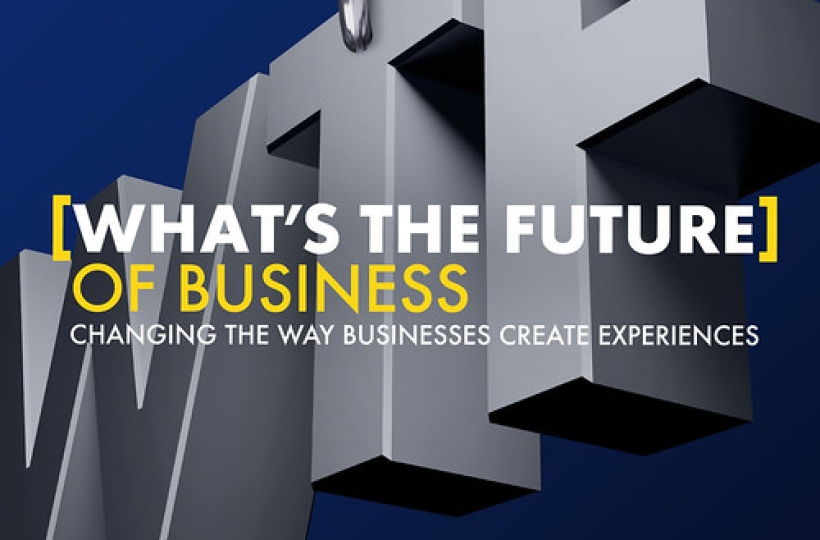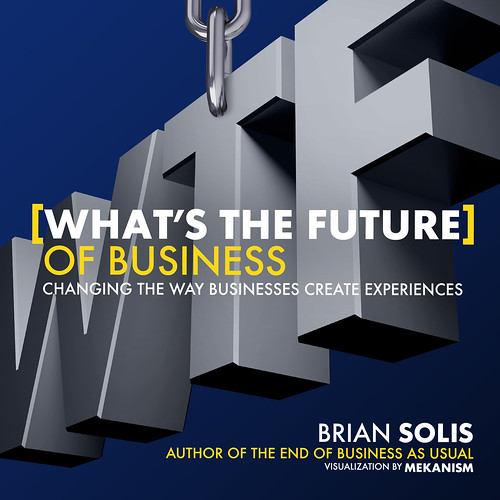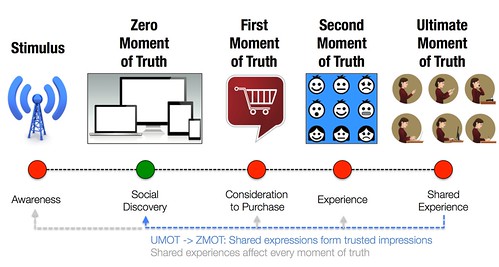My interview with @BrianSolis on ‘the future of business’

Brian Solis recently released his new book ‘What’s the Future of Business’. I had the pleasure of having a chat with Brian about his new book. Here is the summary of our talk. Hope you enjoy it. Thanks Brian for making time for this, appreciate it.
So, Brian, tell us: what is the future of business?
Steven, thefuture of businessis what you want to make of it. Nothing less…nothing more. Either you want to lead and be relevant or you want to react and hope to keep up. Anything in between in either ignorant or arrogant and neither one will contribute to long term success.
Ignorance + Arrogance = Ignorance
I believe that the future of a brand and thus the business at large lies in shared experiences. People have always talked to one another. Their words have influenced the impressions and perceptions in varying ways going back to the beginning of time. The difference is that we live in a social economy driven by a digital exchange. Here the currency is online via shared experiences and the value of a brand’s net worth is measured in the accumulation of positive exchanges. Thus the future of business is up to the business itself to define the experience and the experience that should be in turn felt and shared. The memory of the experience not only lingers within individuals but also the memory of the experience isn encapsulated digitally and enlivened through contextual searches within relevant networks now and over time.
You speak about innovative leadership with an impact on business results. Whatdo you mean with innovative leadership and do you have an example?
Innovative leadership is measured in a number of ways. It starts with fixing things that may not be broken. For example, many businesses I work with question the need to innovate at a time when businesses are showing strong profitability and performance. But as you and I know, nothing lasts forever and everything is open to disruption. This is why digital analytics combined with digital anthropology and ethnography are critical. Businesses can track how their businesses Essentially, the heart of innovative leadership strives to remain relevant with changes in customer and employee behavior and expectations. Additionally true leaders look at how technology impacts markets or the potential to do so to survive digital darwinism, the phenomenon that occurs when technology and society evolve faster than the ability to adapt.
You most often here about innovative leaders such as Richard Branson or Tony Hsieh. While they’re blazing trails on their own, there are also remarkable individuals who are disrupting “business as usual” by merging visual and leadership with entrepreneurship and business hacking. This list includes:
Jack Dorsey and his attempt to rethink the cash register and the receipt with Square
Daniel Kim and his work at Lit Motors, which is combining the idea of a motorcycle, Segway and electric car into a revolutionary form of transport.
Mike Del Ponte and Ido Leffler are reinventing the water filtration experience by fusing the art and beauty of wine decanting with the taste and performance of modern and organic materials that rival the best in the business.
Inthis new story, you talk about the 4 moments of thruth, can you explainthem to us?
The four moments of truth define what we refer to most commonly as the sales funnel or today as the Dynamic Customer Journey (Altimeter Group). It goes as follows…
Post stimulus, a customer enters the Zero Moment of Truth, the point where discovery begins.
Next, they move toward the First Moment of Truth. Customers are close to making a purchase, but other factors still come into play such as competitive advertising, packaging, special/promotions, engagement by sales representatives, collateral and online information.
The next phase is the Second Moment of Truth. This is where your customers begin the journey of essentially being a customer. Their experience with the product, post transaction engagement with the company, and also reactions from peers shapes impressions, sentiment and overall satisfaction.
Lastly, the Ultimate Moment of Truth is where customers share their experience with others using the channels available to them. Previously word of mouth was instrumental in influencing impressions and decisions. In a connected society, these shared experiences populate every facet of the web, from static to social to mobile. Whether it’s a review site, social networks, self-publishing platforms, mobile apps, shared experiences are the new “Google” search result and they can’t be SEO optimized without first investing in the experience you want people to have and share. And, these shared experiences aren’t the “snap chat” of emotions that come and go. Once published, they stay online for all to discover. At some point they become more influential than how businesses market and brand themselves today and that’s the point. It’s not just what you say about you, it’s what others say and share that shapes your brand and the perceptions that orbit it. As we become more connected, this only amplifies and permeates.
This is what the book is about.
It explores each moment of truth and how technology and behavior are evolving. But, it doesn’t focus on technology, the book focuses on experience architecture. To succeed in the future takes a proactive approach, not just one that reacts to the latest tech and trends.
The future of business isn’t created, it’s co-created.
I’d like to end with this…I believe so much in the future of shared experiences that I used the print version of this book to make that very point. Its the first coffee table book for business executives. The shape of WTF is square. It’s rich in color and imagery. In fact, I refer to it as an analog app. Why would I write another business book with the same shape, font, design, paper as ever other book out there? Why would I follow protocol and tradition when I profess that consumer behavior and expectations are evolving?
While the book took a notable amount of time to write, I invested a greater span of time in understanding UX and design to appeal to Generation-C. They/we read online, engage in apps, consume inforgraphics and other cool imagery, and watch short online videos. Everything it takes to become not only digestible but shareable is different now. WTF is the first book designed to appeal to a variety of people to present deep information in a way that readers can appreciate their way.
I worked withMekanism, the team behind the Pepsi/Beyond commercial for the 2013 Super Bowl and also Hugh MacCleod (@GapingVoid) and theSocial Object Factoryteam to design a book that looks, feels, and acts just like a digital experience. It even has an virtual nav bar to help you guide your experience.
As you can imagine, changing the format for a book isn’t a simple proposition. Books can often follow a business as usual process. This was in the very least, a challenge from beginning to end. I will say though that it was worth it for every reason you can and can’t imagine…and again, that’s the point. If I can change the experience of a printed book, if I can make a book a social object, if I can change how people react and influence with a book, imagine what you can do…
#WTF

